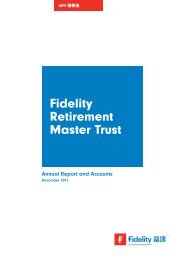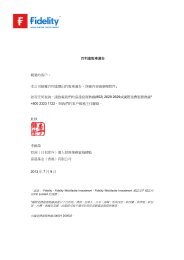SKANDIA GLOBAL FUNDS PLC - Fidelity Investments
SKANDIA GLOBAL FUNDS PLC - Fidelity Investments
SKANDIA GLOBAL FUNDS PLC - Fidelity Investments
You also want an ePaper? Increase the reach of your titles
YUMPU automatically turns print PDFs into web optimized ePapers that Google loves.
Skandia Global Funds plc<br />
Annual Report and Audited Financial Statements for the year ended 31 December 2011<br />
<strong>SKANDIA</strong> <strong>GLOBAL</strong> BOND FUND<br />
INVESTMENT ADVISER’S REPORT FOR THE YEAR ENDED 31 December 2011<br />
Skandia Global Bond Fund – Wellington Management Company, LLP<br />
Investment Adviser’s Commentary (continued)<br />
The fund marginally outperformed the benchmark Barclays Capital Global Aggregate Index in the third quarter, returning 1.01%<br />
versus 0.97% for the index.* Duration, country, currency and yield curve strategies all benefited performance. Macro-driven duration<br />
strategies in Germany, Sweden and the US provided the largest positive impact on returns, although a tactical short in the UK ten year<br />
sector detracted. In addition a long US 30 year versus short French 30 year trade added to returns.<br />
In FX, macro currency strategies were positive overall. Our overweight US Dollar versus commodity currencies (Australia, New<br />
Zealand and Canada) had the biggest positive impact. However, our underweight positioning in the Swedish Krona also added to<br />
results. More generally, being overweight the US Dollar added to results.<br />
Credit strategies were largely unhelpful during the third quarter. The portfolio‟s overweight position in investment grade corporates<br />
detracted from results, mainly due to widening credit spreads. However, favourable positions in German bonds versus underweights<br />
to peripheral Europe (Austria, Belgium and Portugal) were positive. Our underweight to covered bonds was another positive during<br />
the quarter.<br />
Quantitatively-oriented strategies benefited returns, as significant volatility in the quarter created attractive shorter-term opportunities,<br />
especially in the UK and Germany. Specifically, long UK ten-year versus short US ten-year positions in the early part of September<br />
were primary contributors. Value strategies struggled as we began building short US relative value contrarian positions starting in the<br />
middle of the quarter. Partially offsetting the weakness was the exit of the long US ten-year versus short Germany ten-year positions,<br />
which were built early in the quarter, and later closed at a profit.<br />
The Fund underperformed its benchmark index in the fourth quarter. Macro-driven country strategies were marginally negative<br />
resulting from a long German ten-year versus short US ten-year position. Tactical overweight positions in UK ten-year debt detracted<br />
from the results as well, as did tactical underweight positions in US 30-year debt. Macro driven duration strategies that had the biggest<br />
impact during the quarter included: tactical positions in German five and ten-year issues and Swedish five-year issues, which added to<br />
returns.<br />
Macro currency strategies were also positive, for example, an overweight to the US Dollar versus high-beta currencies like the<br />
Turkish Lira and the Brazilian Real had the largest positive impact during the quarter. The portfolio‟s tactical overweight in NZD<br />
versus USD and CHF also added to results.<br />
Credit strategies were largely positive for the quarter, with an overweight position in investment grade corporates and CMBS<br />
benefiting performance. Portfolio positions in German bonds versus an underweight in peripheral Europe (Austria, Portugal) were<br />
also favourable, as was an underweight to covered bonds. Quantitative strategies in the portfolio also proved largely positive for<br />
returns. The significant volatility seen in the quarter created attractive opportunities. Among the primary contributors were long<br />
German relative-value trades which the Investment Adviser started adding in November. Specifically, a long German ten-year versus<br />
short US ten-year position was the biggest positive. German yields experienced one their most volatile periods on record during the<br />
quarter, rising sharply in November following an undersubscribed auction, then falling to all-time lows in December as inflation<br />
expectations dropped.<br />
The Investment Adviser quantitative process identified the German ten-year sector as quite cheap and attractive compared with<br />
other markets, and in particular the US. In addition, long UK ten-year versus short US ten-year positions also greatly contributed,<br />
especially earlier in the quarter.<br />
Source: Wellington Management Company, LLP as at 31 December 2011.<br />
*Performance figures refer to Class A1 shares and are sourced from Morningstar. Calculation basis: bid to bid, net of fees, gross<br />
income reinvested in fund base currency (US Dollars).<br />
References to benchmarks are for illustrative purposes only and are not intended to imply a performance objective. There is no<br />
guarantee that the Skandia Global Bond Fund will outperform this benchmark.<br />
44

















